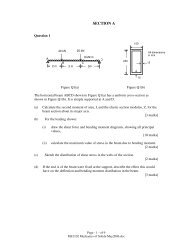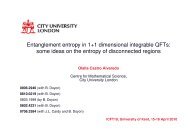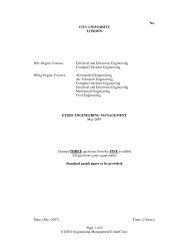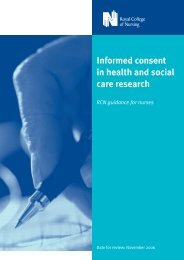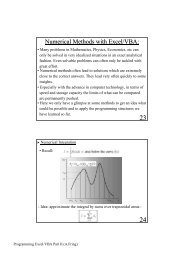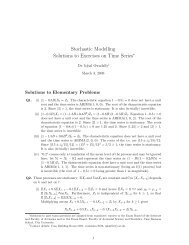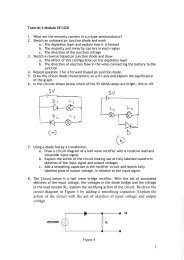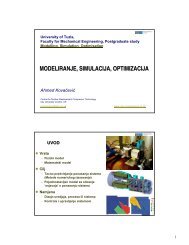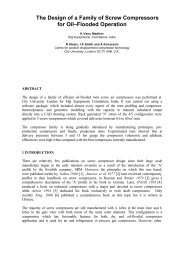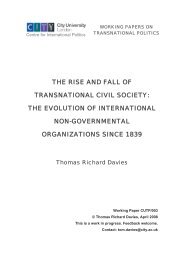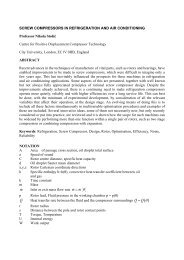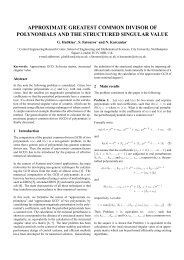What is the non-sign repetition test? - Staff.city.ac.uk
What is the non-sign repetition test? - Staff.city.ac.uk
What is the non-sign repetition test? - Staff.city.ac.uk
Create successful ePaper yourself
Turn your PDF publications into a flip-book with our unique Google optimized e-Paper software.
SignMatters<br />
The magazine for <strong>the</strong> <strong>sign</strong> community<br />
How do deaf children make <strong>sign</strong>s?<br />
- The Nonsense-Sign Repetition Project<br />
Wolfgang Mann, Chloe Marshall, and Gary Morgan<br />
Phonology <strong>is</strong> a subfield of lingu<strong>is</strong>tics which studies how<br />
meaningless units of a language are combined to create<br />
larger, meaningful ones (words in spoken languages,<br />
<strong>sign</strong>s in <strong>sign</strong>ed languages). In a spoken language such<br />
as Engl<strong>is</strong>h, <strong>the</strong>se meaningless units are sounds, such as<br />
'n', 'a' and 'p'. Sounds can be put toge<strong>the</strong>r to create<br />
different words, as in 'nap' and 'pan'. The meaningless<br />
units of a <strong>sign</strong> language such as BSL include a range of<br />
different parameters such as handshapes, orientations,<br />
locations and movements. These parameters are<br />
combined in different ways to change meaning. For<br />
example, in BSL, a meaningless unit would be <strong>the</strong><br />
location of <strong>the</strong> <strong>sign</strong> in NAME (forehead) and AFTERNOON<br />
(chin).<br />
Just as in Engl<strong>is</strong>h children find some sounds harder to learn<br />
than o<strong>the</strong>rs ('th' and 'r' are particularly difficult), in BSL some<br />
aspects of <strong>sign</strong>s are harder to learn than o<strong>the</strong>rs. With regards<br />
to handshape, for example, some handshapes are very<br />
common, easy to produce, and easily d<strong>is</strong>tingu<strong>is</strong>hable from<br />
o<strong>the</strong>r handshapes. These are readily learnt, even by young<br />
children. O<strong>the</strong>r handshapes are less common, and are harder<br />
to produce and to perceive, so <strong>the</strong>y are learnt later. Lingu<strong>is</strong>ts<br />
call easy handshapes 'unmarked' and more difficult ones<br />
'marked'.<br />
For instance, take <strong>the</strong> <strong>sign</strong> for MIRROR shown in figure #1.<br />
Mirror uses an unmarked handshape, with <strong>the</strong> thumb and all<br />
fingers extended.<br />
Figure 1<br />
An example of a marked handshape <strong>is</strong> in <strong>the</strong> <strong>sign</strong> for NEW<br />
YORK (see figure #2)<br />
Figure 2<br />
In BSL, unmarked handshapes (see figure #3) are found in half<br />
of all <strong>sign</strong>s.<br />
Figure 3<br />
16 September 2007
SignMatters<br />
The magazine for <strong>the</strong> <strong>sign</strong> community<br />
Ano<strong>the</strong>r aspect of <strong>sign</strong>s that can be difficult to learn <strong>is</strong> when a<br />
<strong>sign</strong> contains two simultaneous movements, known as a<br />
'movement cluster' (e.g., THROW). Sometimes young children<br />
delete one of <strong>the</strong> movements or produce <strong>the</strong>m one after <strong>the</strong><br />
o<strong>the</strong>r instead of at <strong>the</strong> same time. And you can imagine that<br />
<strong>sign</strong>s with a marked handshape and a movement cluster,<br />
which are really complex, would be particularly difficult for<br />
young children to learn!<br />
Figure 5<br />
We are interested in studying how deaf children between <strong>the</strong><br />
ages of 3 and 10 years learn different aspects of phonology,<br />
such as marked handshapes and movement clusters, in order<br />
to understand more about <strong>the</strong> nature of BSL and how it <strong>is</strong><br />
<strong>ac</strong>quired.<br />
The Nonsense-Sign Repetition Task:<br />
For our study, we developed a quick assessment <strong>test</strong><br />
specifically for children who are deaf and who are learning<br />
BSL. In th<strong>is</strong> computer-based <strong>test</strong>, participants are shown a<br />
series of <strong>non</strong>sense <strong>sign</strong>s (<strong>sign</strong>s that could be real <strong>sign</strong>s of BSL<br />
but have no meaning) and have to repeat <strong>the</strong>m with a brief<br />
delay. Th<strong>is</strong> task requires perception and production skills from<br />
<strong>the</strong> deaf participants, as well as <strong>the</strong> ability to remember e<strong>ac</strong>h<br />
<strong>sign</strong> for a short time until <strong>the</strong>y are asked to repeat it.<br />
Respondents are videoed while repeating <strong>the</strong> <strong>sign</strong>s and we<br />
later score how <strong>ac</strong>curately <strong>the</strong>y repeated different phonological<br />
aspects of <strong>the</strong> <strong>sign</strong>, such as handshape and movement (for<br />
examples of <strong>non</strong>sense <strong>sign</strong>s, see figures 4 & 5)<br />
Figure 4<br />
One of our long-term goals <strong>is</strong> that th<strong>is</strong> tool could become a<br />
useful assessment tool for speech and language <strong>the</strong>rap<strong>is</strong>ts<br />
who work with deaf children. Currently, <strong>the</strong>re are very few<br />
language assessment <strong>test</strong>s that are appropriate for deaf<br />
children, and <strong>non</strong>e that specifically target phonology.<br />
For our project, we collected data from 100 deaf children aged<br />
3-10 years at schools/services for <strong>the</strong> Deaf throughout <strong>the</strong> UK. In<br />
addition to <strong>the</strong> Nonsense-Sign Repetition Task, we admin<strong>is</strong>tered<br />
two motoric skills tasks and compared <strong>the</strong> results in order to see<br />
whe<strong>the</strong>r fine motor skills predict <strong>sign</strong> language ability. In one<br />
task participants were asked to thread a number of beads on a<br />
string. In <strong>the</strong> o<strong>the</strong>r, <strong>the</strong>y used <strong>the</strong>ir thumbs/index fingers to do<br />
<strong>the</strong> 'itsy-bitsy-spider'. Both tasks were timed. E<strong>ac</strong>h child was<br />
<strong>test</strong>ed individually, and <strong>the</strong> <strong>test</strong>ing took between 15 and 20<br />
minutes. Children's performance on <strong>the</strong> Nonsense-Sign<br />
Repetition task was also compared to <strong>the</strong>ir results from a BSL<br />
comprehension <strong>test</strong> (BSL Receptive Skills Test, Herman et al.,<br />
1999) that <strong>is</strong> regularly admin<strong>is</strong>tered by most schools.<br />
Over <strong>the</strong> summer we have been scoring and analysing <strong>the</strong> data<br />
from all our deaf participants. The first results show that children<br />
repeat <strong>non</strong>sense-<strong>sign</strong>s more <strong>ac</strong>curately as <strong>the</strong>y get older, which<br />
<strong>is</strong> not surpr<strong>is</strong>ing. However, <strong>the</strong>y find it harder to repeat<br />
handshapes than hand internal or path movements.<br />
Fur<strong>the</strong>rmore, as <strong>non</strong>sense-<strong>sign</strong>s increase in phonological<br />
complexity, children find <strong>the</strong>m harder to repeat. Findings also<br />
indicate a relationship between deaf children's ability to repeat<br />
<strong>non</strong>sense-<strong>sign</strong>s, <strong>the</strong>ir scores on <strong>the</strong> BSL comprehension <strong>test</strong> and<br />
<strong>the</strong>ir fine motor control. Overall, <strong>the</strong> results suggest that <strong>the</strong><br />
<strong>ac</strong>qu<strong>is</strong>ition of phonology and fine motor control are very<br />
important for children's <strong>sign</strong> language development.<br />
References:<br />
Herman, R., Holmes, S. & B. Woll (1999). Assessing BSL Development -<br />
Receptive Skills<br />
Test. Coleford, UK: The Forest Bookshop.<br />
Cont<strong>ac</strong>t Info: Wolfgang Mann, Deafness Cognition and Language<br />
Research Centre, 49 Gordon Square, WC1H 0PD, London, email:<br />
wmann@ucl.<strong>ac</strong>.<strong>uk</strong>.<br />
www.<strong>sign</strong>community.org.<strong>uk</strong><br />
17



